Fractional Order Modeling the Gemini Virus in Capsicum annuum with Optimal Control
Abstract
1. Introduction
- (A)
- The fractional model of Geminivirus in C. annuum with AB-derivative constructed.
- (B)
- We obtained some stability results of this fractional model and discussed the equilibrium points and reproductive number of the model.
- (C)
- We derived the optimal control of this fractional model and plotted the population and comparison results of each variable in the model.
2. Preliminaries
3. Modeling Framework of Gemini Virus
- •
- denotes a set of noninfected C. annuum in vegetative phase liable to possible infection.
- •
- denotes a set of infected C. annuum in vegetative phase.
- •
- denotes a set of noninfected C. annuum in generative phase liable to possible infection.
- •
- denotes a set of infected C. annuum in generative phase.
- •
- denotes a set of noninfected B. tabaci(white bug) liable to possible infection.
- •
- denotes a set of infected B. tabaci.
4. Basic Analysis of the Model
4.1. Invariant Region
4.2. Disease-Free Equilibrium Point
4.3. Reproduction Number
5. Optimal Control
- Adjoint equations:
- Transversality conditions:
- Optimality conditions:Furthermore, the control functions are given by,
6. Numerical Results
7. Conclusions
Author Contributions
Funding
Institutional Review Board Statement
Informed Consent Statement
Data Availability Statement
Acknowledgments
Conflicts of Interest
References
- Mariyono, J. Impacts seed technology improvement on economic aspects of chilli production in central java-Indonesia. J. Ekon. Pembang. 2016, 17, 1–14. [Google Scholar] [CrossRef][Green Version]
- Khan, F.A.; Mahmood, T.; Ali, M.; Saeed, A.; Maalik, A. Pharmacological importance of an ethnobotanical plant: Capsicum annuum L. Nat. Prod. Res. 2014, 28, 1267–1274. [Google Scholar] [CrossRef] [PubMed]
- Subban, R.; Sundaram, K. Effect of Antiviral Formulations on Chilli Leaf Curl Virus (CLCV) Disease of Chilli Plant (Capsicum annuum L.). J. Pharm. Res. 2012, 5, 5363–5366. [Google Scholar]
- Solahudin, M.; Pramudya, B.; Manaf, R. Gemini Virus Attack Analysis in Field of Chili (Capsicum annuum L.) Using Aerial Photography and Bayesian Segmentation Method. Procedia Environ. Sci. 2015, 24, 254–257. [Google Scholar] [CrossRef][Green Version]
- Ganefianti, D.W.; Hidayat, H.S.; Syukur, M. Susceptible Phase of Chili Pepper Due to Yellow Leaf Curl Begomovirus Infection. Int. J. Adv. Sci. Eng. Inf. Technol. 2017, 7, 594–601. [Google Scholar] [CrossRef]
- Bouhous, M.; Larous, L. Efficiency of the entomopathogenic fungus Verticillium lecanii in the biological control of Trialeurodes vaporariorum, (Homoptera: Aleyrodidae), a greenhouse culture pest. Afr. J. Microbiol. Res. 2012, 6, 2435–2442. [Google Scholar]
- Alavo, T.B.C. The insect pathogenic fungus Verticillium lecanii (Zimm.) Viegas and its use for pests control: A review. J. Exp. Biol. Agric. Sci. 2015, 3, 337–345. [Google Scholar]
- Sopp, P.I.; Gillespie, A.T.; Palmer, A. Application of Verticillium lecanii for the control of Aphis gossypii by a low-volume electrostatic rotary atomiser and a high-volume hydraulic sprayer. Entomophaga 1989, 34, 417–428. [Google Scholar] [CrossRef]
- Podlubny, I. Fractional Differential Equations: An Introduction to Fractional Derivatives, Fractional Differential Equations, to Methods of Their Solution and Some of Their Applications; Academic Press: San Diego, CA, USA, 1999. [Google Scholar]
- Ross, B. A brief history and exposition of the fundamental theory of fractional calculus. Fract. Calc. Appl. 2006, 457, 1–36. [Google Scholar]
- Caputo, M.; Fabrizio, M. On the notion of fractional derivative and applications to the hysteresis phenomena. Meccanica 2017, 52, 3043–3052. [Google Scholar] [CrossRef]
- Atangana, A.; Hammouch, Z. Fractional calculus with power law: The cradle of our ancestors. Eur. Phys. J. Plus 2019, 134, 429. [Google Scholar] [CrossRef]
- Arqub, O.A.; Al-Smadi, M. Numerical solutions of Riesz fractional diffusion and advection-dispersion equations in porous media using iterative reproducing kernel algorithm. J. Porous Media 2020, 23, 783–804. [Google Scholar] [CrossRef]
- Arqub, O.A.; Shawagfeh, N. Application of reproducing kernel algorithm for solving Dirichlet time-fractional diffusion-Gordon types equations in porous media. J. Porous Media 2019, 22, 411–434. [Google Scholar] [CrossRef]
- Arqub, O.A. Application of residual power series method for the solution of time-fractional Schrodinger equations in one-dimensional space. Fundam. Informaticae 2019, 166, 87–110. [Google Scholar] [CrossRef]
- Djennadi, S.; Shawagfeh, N.; Arqub, O.A. A fractional Tikhonov regularization method for an inverse backward and source problems in the time-space fractional diffusion equations. Chaos Solitons Fractals 2021, 150, 111127. [Google Scholar] [CrossRef]
- Atangana, A.; Baleanu, D. New fractional derivatives with non-local and non-singular kernel: Theory and application to heat transfer model. Therm. Sci. 2016, 20, 763–769. [Google Scholar] [CrossRef]
- Jarad, F.; Abdeljawad, T.; Hammouch, Z. On a class of ordinary differential equations in the frame of Atangana–Baleanu derivative. Chaos Solitons Fractals 2018, 117, 16–20. [Google Scholar] [CrossRef]
- Ravichandran, C.; Logeswari, K.; Jarad, F. New results on existence in the framework of Atangana–Baleanu derivative for fractional integro-differential equations. Chaos Solitons Fractals 2019, 125, 194–200. [Google Scholar] [CrossRef]
- Logeswari, K.; Ravichandran, C. A new exploration on existence of fractional neutral integro-differential equations in the concept of Atangana–Baleanu derivative. Physica A 2020, 544, 123454. [Google Scholar] [CrossRef]
- Ravichandran, C.; Logeswari, K.; Panda, S.K.; Nisar, K.S. On new approach of fractional derivative by Mittag–Leffler kernel to neutral integro-differential systems with impulsive conditions. Chaos Solitons Fractals 2020, 139, 110012. [Google Scholar] [CrossRef]
- Bonyah, E.; Gómez-Aguilar, J.F.; Adu, A. Stability analysis and optimal control of a fractional human African trypanosomiasis model. Chaos Solitons Fractals 2018, 117, 150–160. [Google Scholar] [CrossRef]
- Alzahrani, E.O.; Khan, M.A. Modeling the dynamics of Hepatitis E with optimal control. Chaos Solitons Fractals 2018, 116, 287–301. [Google Scholar] [CrossRef]
- Logeswari, K.; Ravichandran, C.; Nisar, K.S. Mathematical model for spreading of COVID-19 virus with the Mittag–Leffler kernel. Numer. Methods Partial. Differ. Equ. 2020, 1–16. [Google Scholar] [CrossRef] [PubMed]
- Tassaddiq, A.; Khan, I.; Nisar, K.S. Heat transfer analysis in sodium alginate based nanofluid using MoS2 nanoparticles: Atangana–Baleanu fractional model. Chaos Solitons Fractals 2020, 130, 109445. [Google Scholar] [CrossRef]
- Korpinar, Z.; Inc, M.; Bayram, M. Theory and application for the system of fractional Burger equations with Mittag leffler kernel. Appl. Math. Comput. 2020, 367, 124781. [Google Scholar] [CrossRef]
- Panda, S.K.; Ravichandran, C.; Hazarika, B. Results on system of Atangana–Baleanu fractional order Willis aneurysm and nonlinear singularly perturbed boundary value problems. Chaos Solitons Fractals 2021, 142, 110390. [Google Scholar] [CrossRef]
- Sweilam, N.H.; Al-Mekhlafi, S.M.; Assiri, T.; Atangana, A. Optimal control for cancer treatment mathematical model using Atangana–Baleanu-Caputo fractional derivative. Adv. Differ. Equ. 2020, 2020, 334. [Google Scholar] [CrossRef]
- Amelia, R.; Anggriani, N.; Supriatna, A.K. Optimal Control Model of Verticillium lecanii Application in the Spread of Yellow Red Chili Virus. WSEAS Trans. Math. 2019, 18, 351–358. [Google Scholar]
- Sweilam, N.H.; L-Mekhlafi, S.M.A. On the optimal control for fractional multi-strain TB model. Optim. Control Appl. Methods 2016, 37, 1355–1374. [Google Scholar] [CrossRef]
- Trigeassou, J.-C.; Maamri, N. Optimal State Control of Fractional Order Differential Systems: The Infinite State Approach. Fractal Fract. 2021, 5, 29. [Google Scholar] [CrossRef]
- Wang, F.; Li, X.; Zhou, Z. Spectral Galerkin Approximation of Space Fractional Optimal Control Problem with Integral State Constraint. Fractal Fract. 2021, 5, 102. [Google Scholar] [CrossRef]
- Caputo, M.; Fabrizio, M. A new Definition of Fractional Derivative without Singular Kernel. Prog. Fract. Differ. Appl. 2015, 1, 73–85. [Google Scholar]
- Brauer, F.; den Driessche, P.V.; Wu, J. Mathematical Epidemiology; Springer: Berlin/Heidelberg, Germany, 2008. [Google Scholar]
- Agrawal, O.P. On a general formulation for the numerical solution of optimal control problems. Int. J. Control 1989, 50, 627–638. [Google Scholar] [CrossRef]
- Agrawal, O.P. Formulation of Euler-Lagrange equations for fractional variational problems. J. Math. Anal. Appl. 2002, 272, 368–379. [Google Scholar] [CrossRef]
- Agrawal, O.P. A formulation and numerical scheme for fractional optimal control problems. IFAC Proc. Vol. 2006, 39, 68–72. [Google Scholar] [CrossRef]
- Agrawal, O.P.; Defterli, O.; Baleanu, D. Fractional optimal control problems with several state and control variables. J. Vib. Control 2010, 16, 1967–1976. [Google Scholar] [CrossRef]
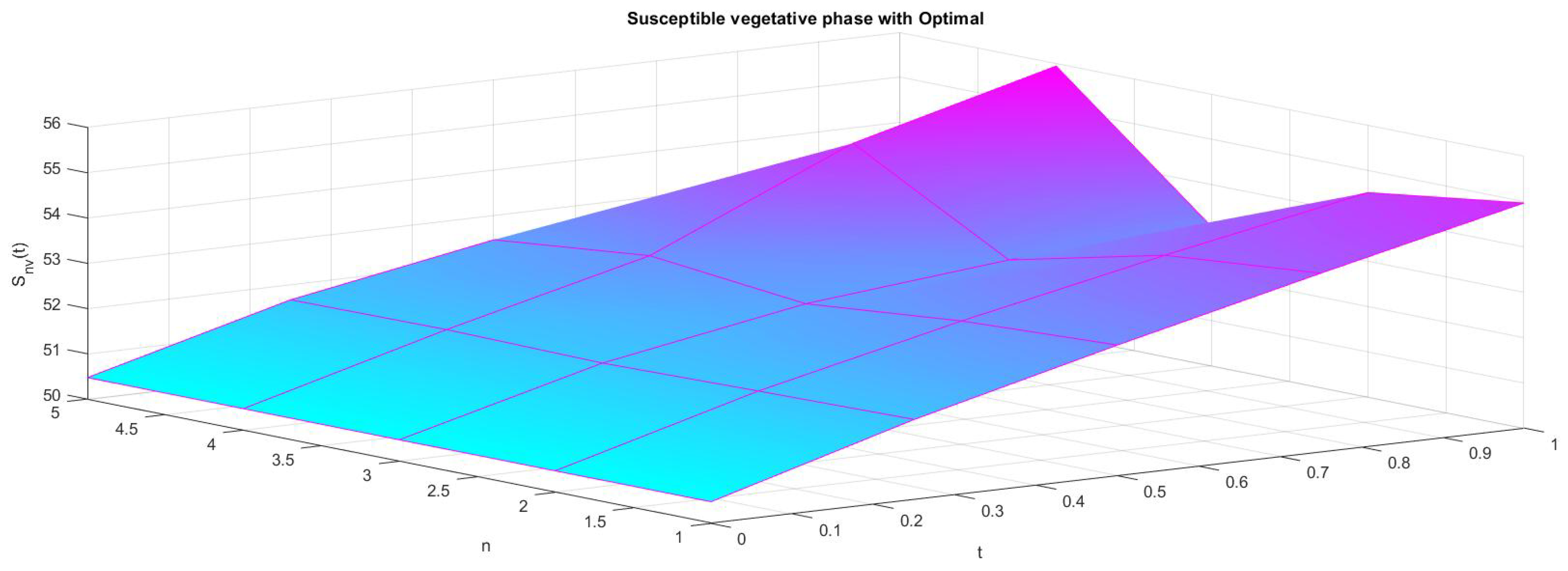
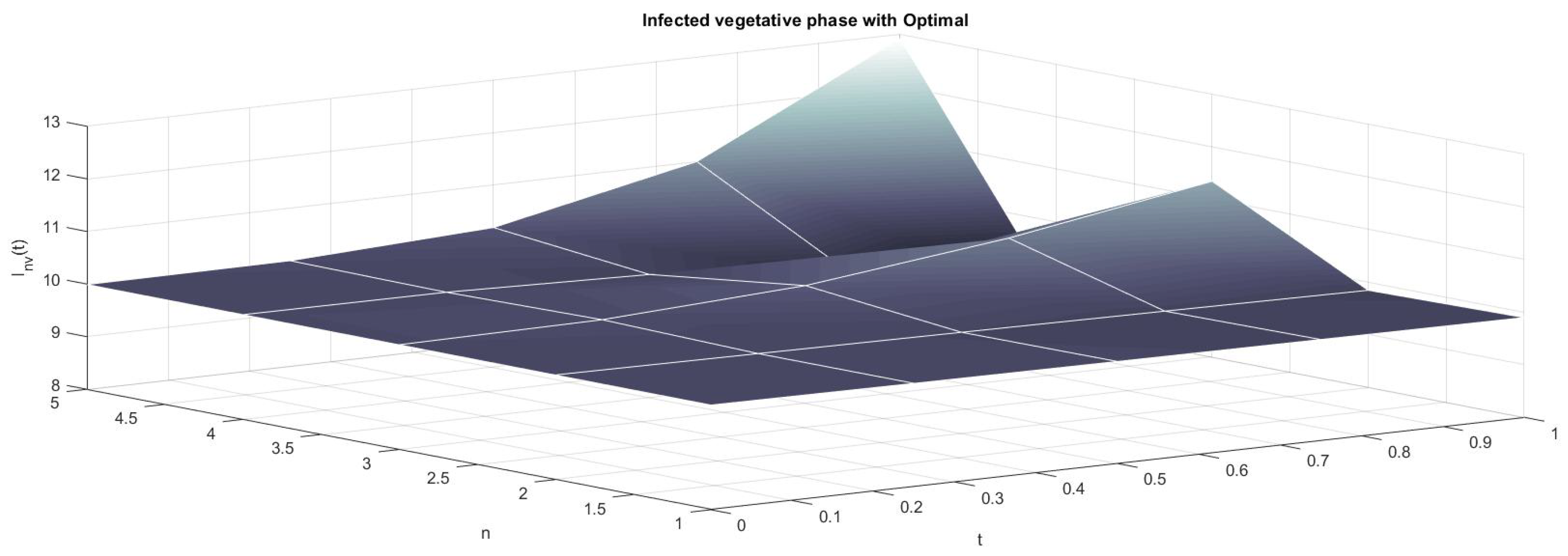
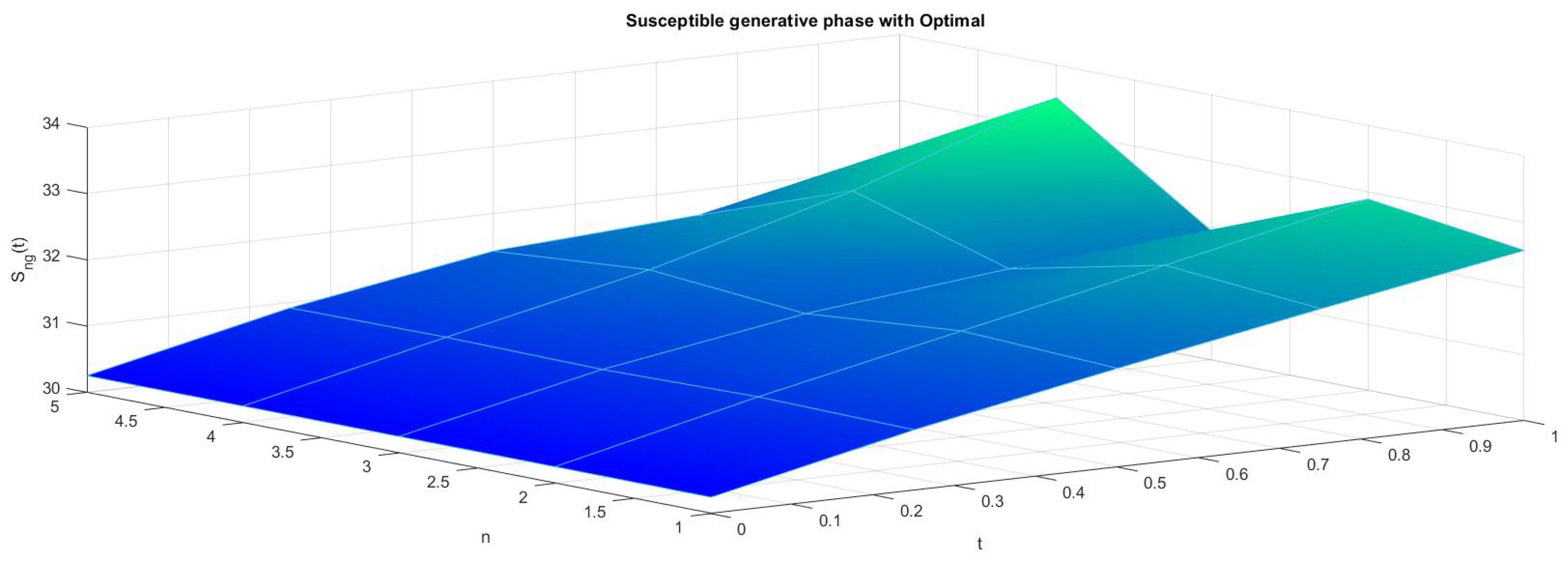
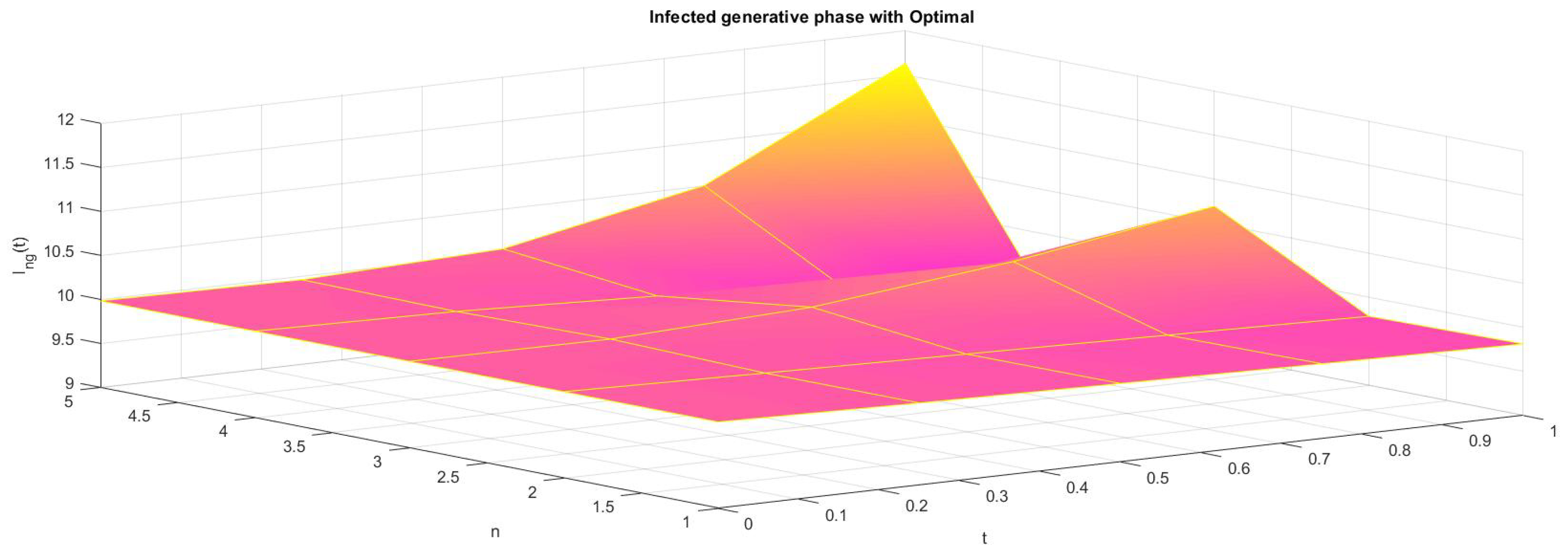
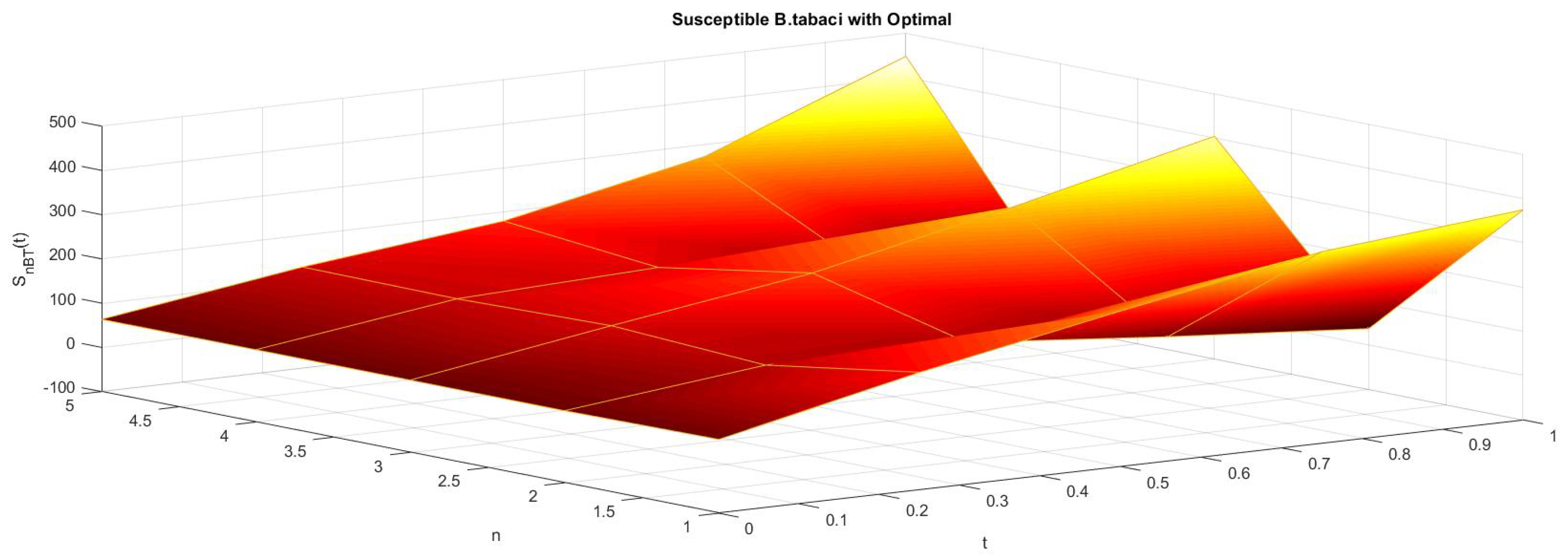
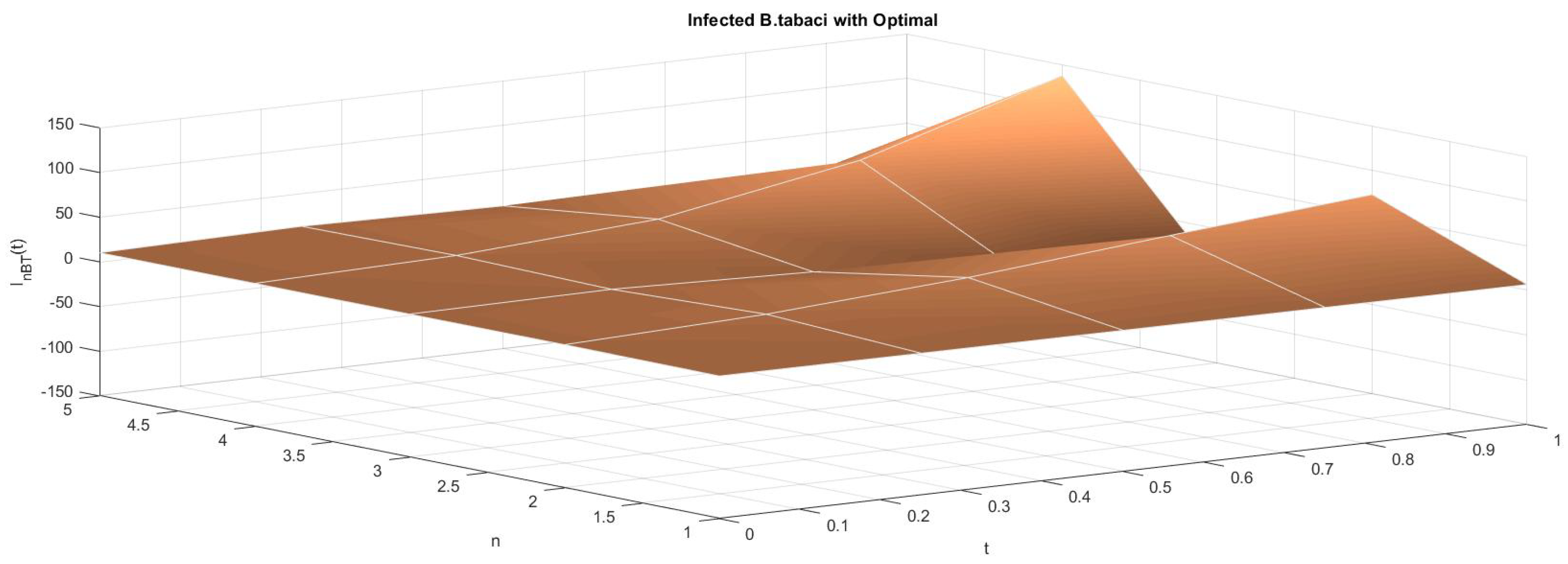
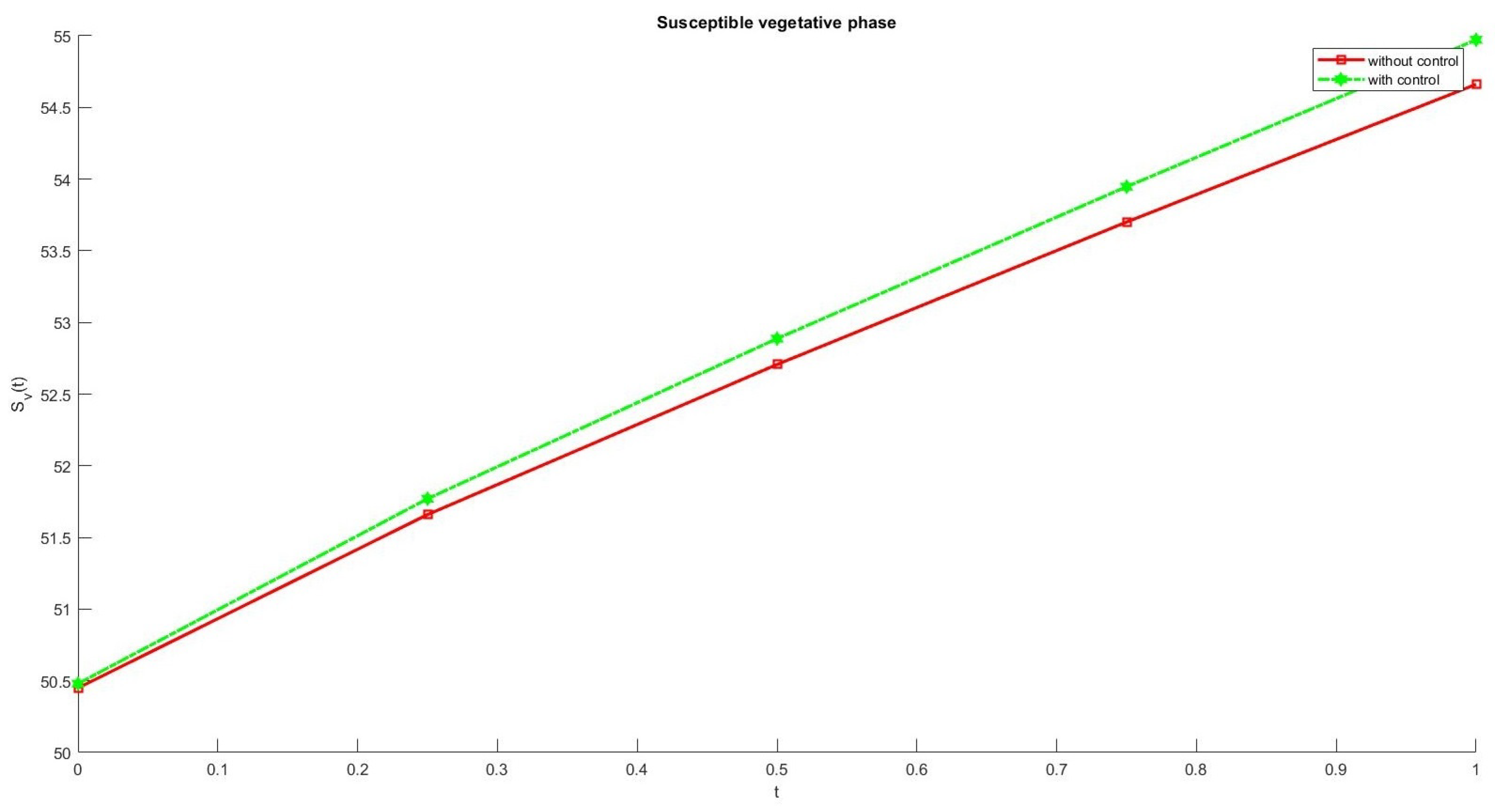
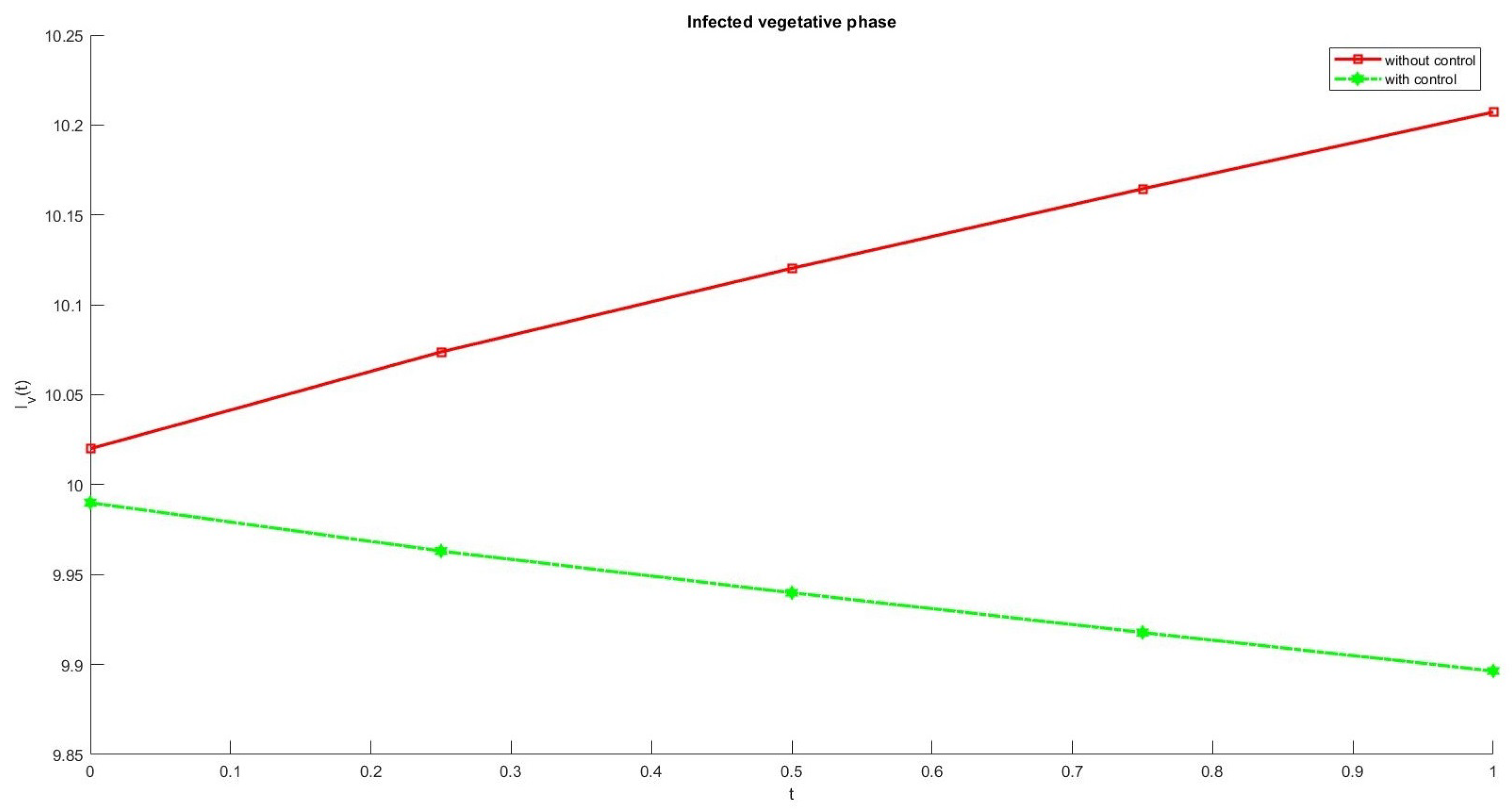
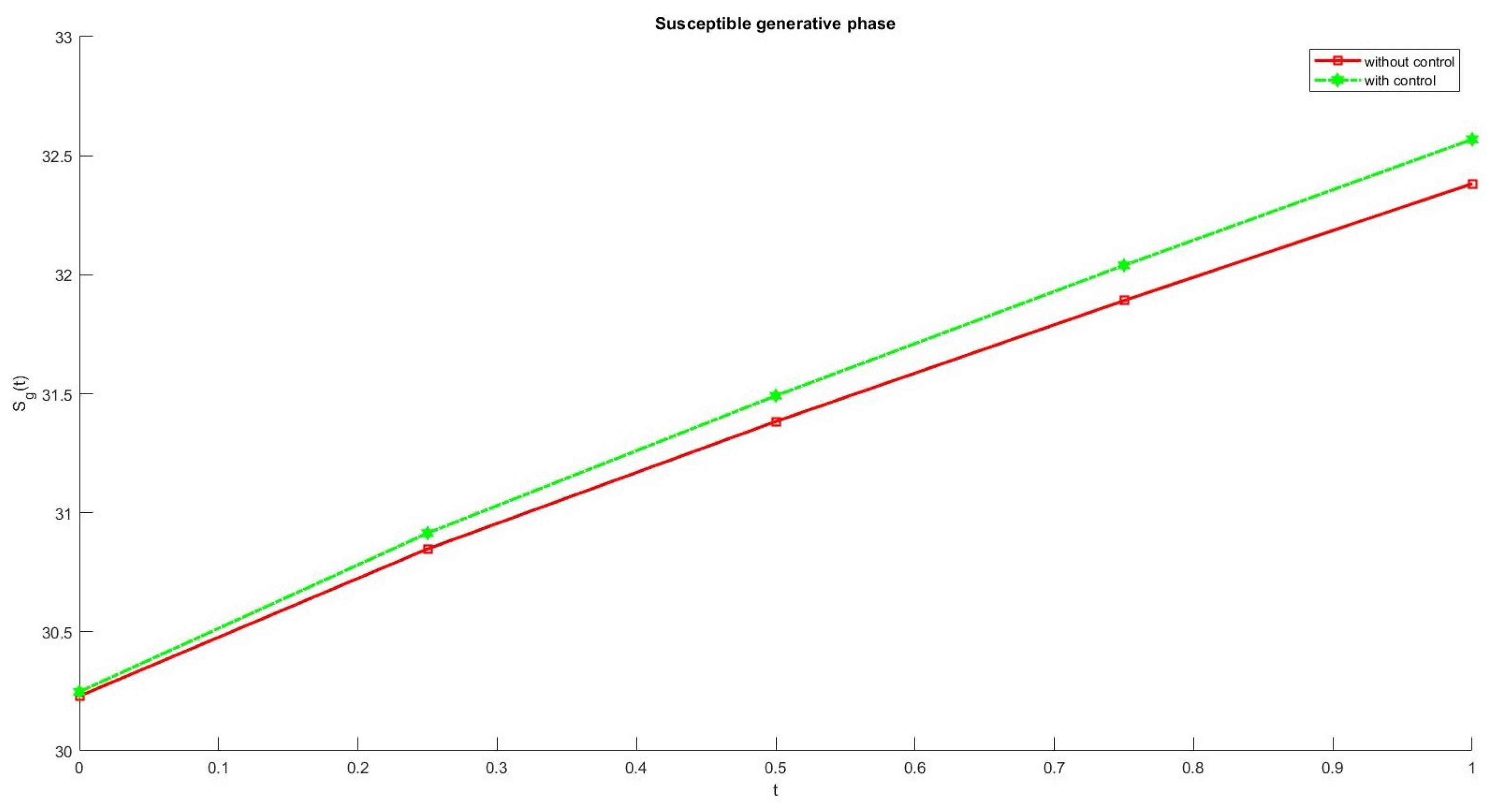
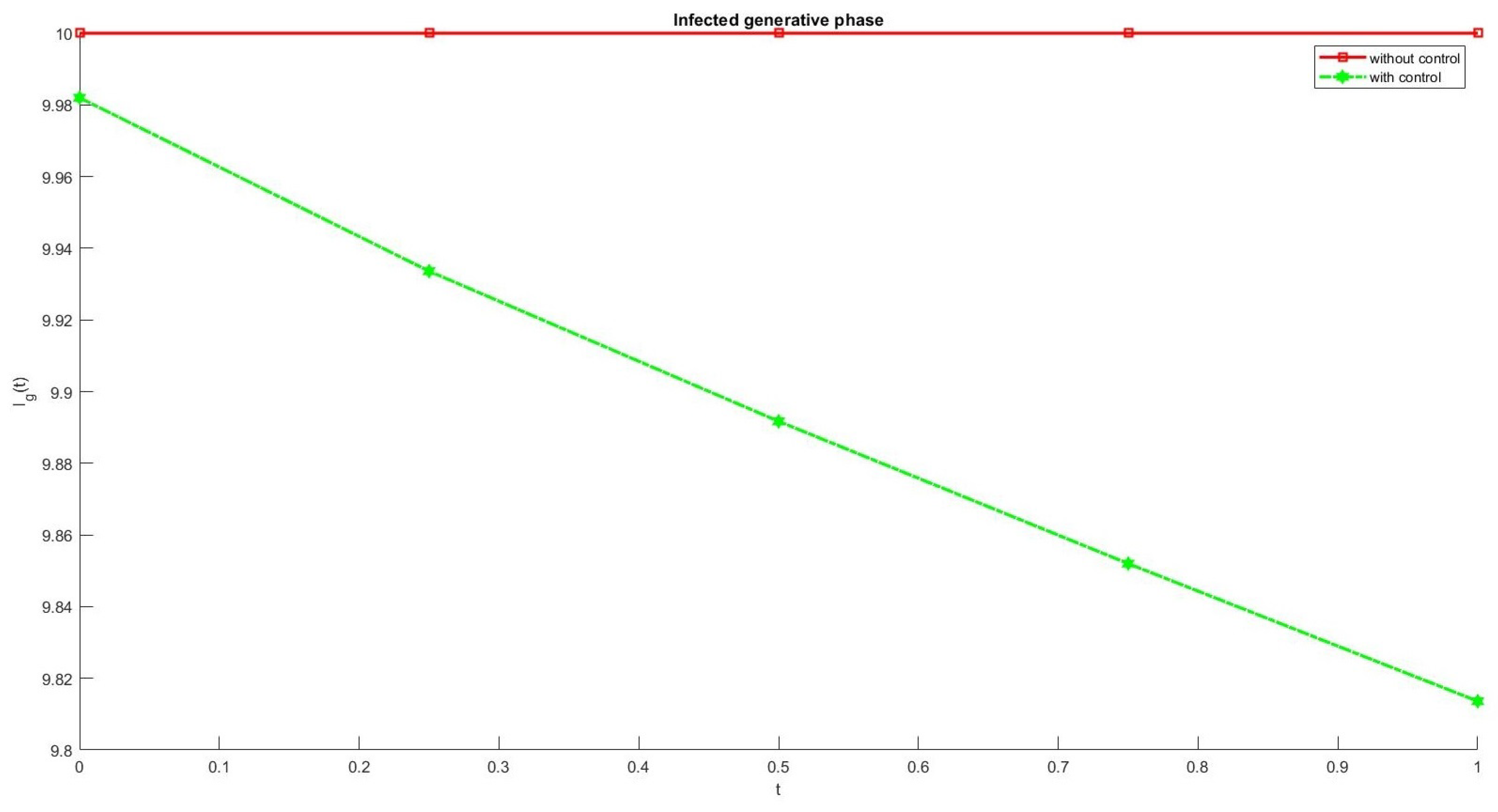
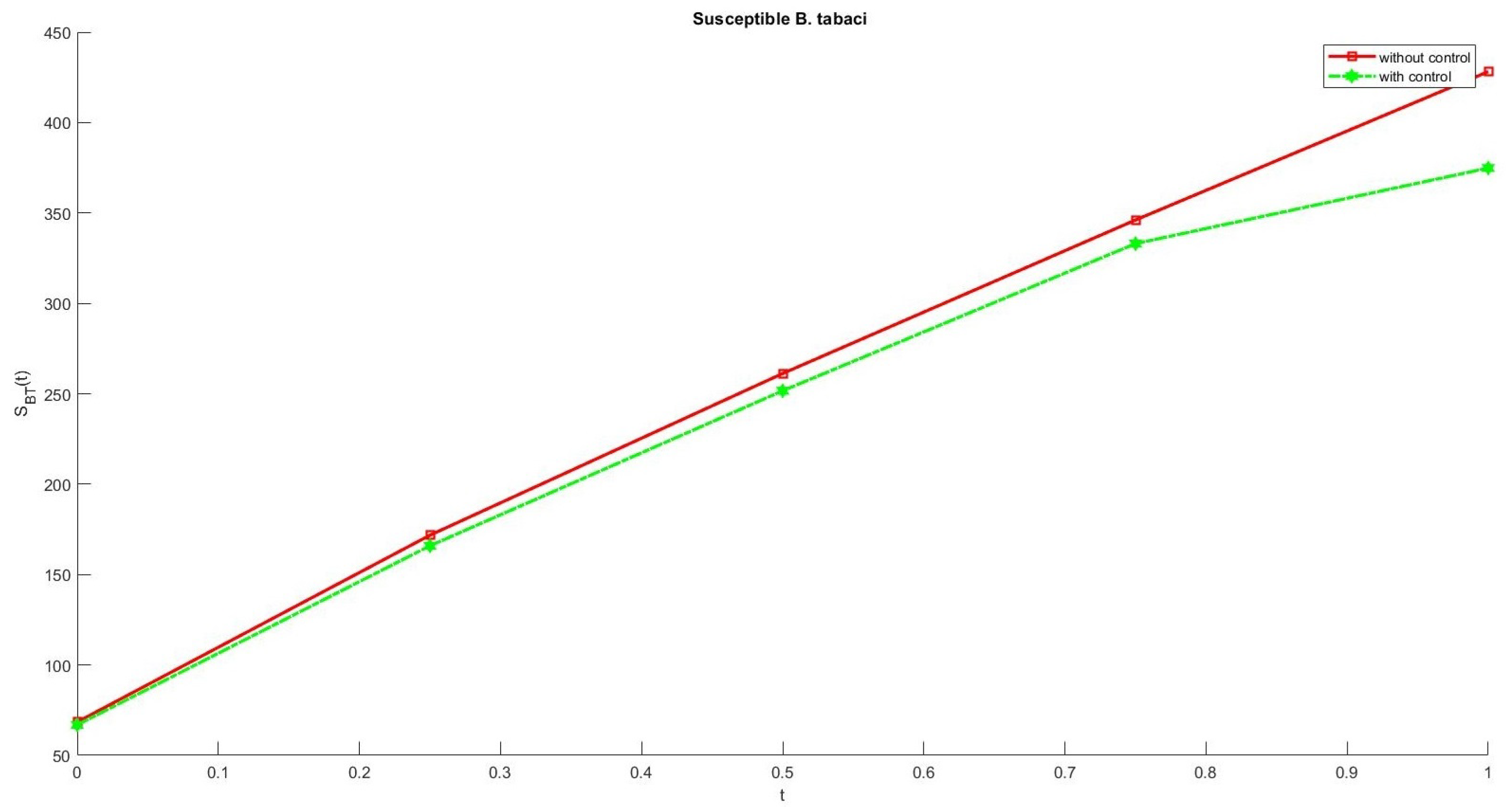
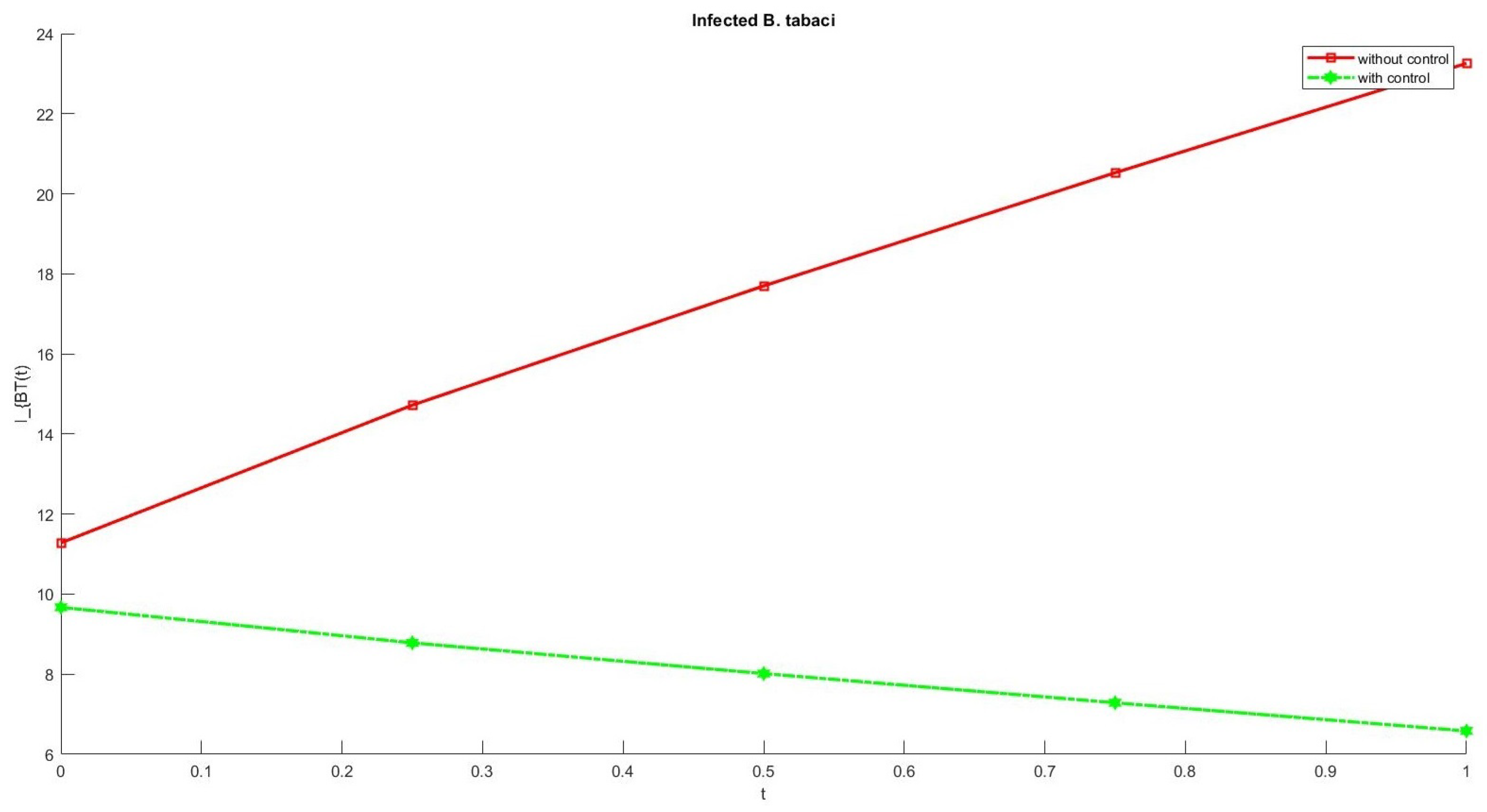
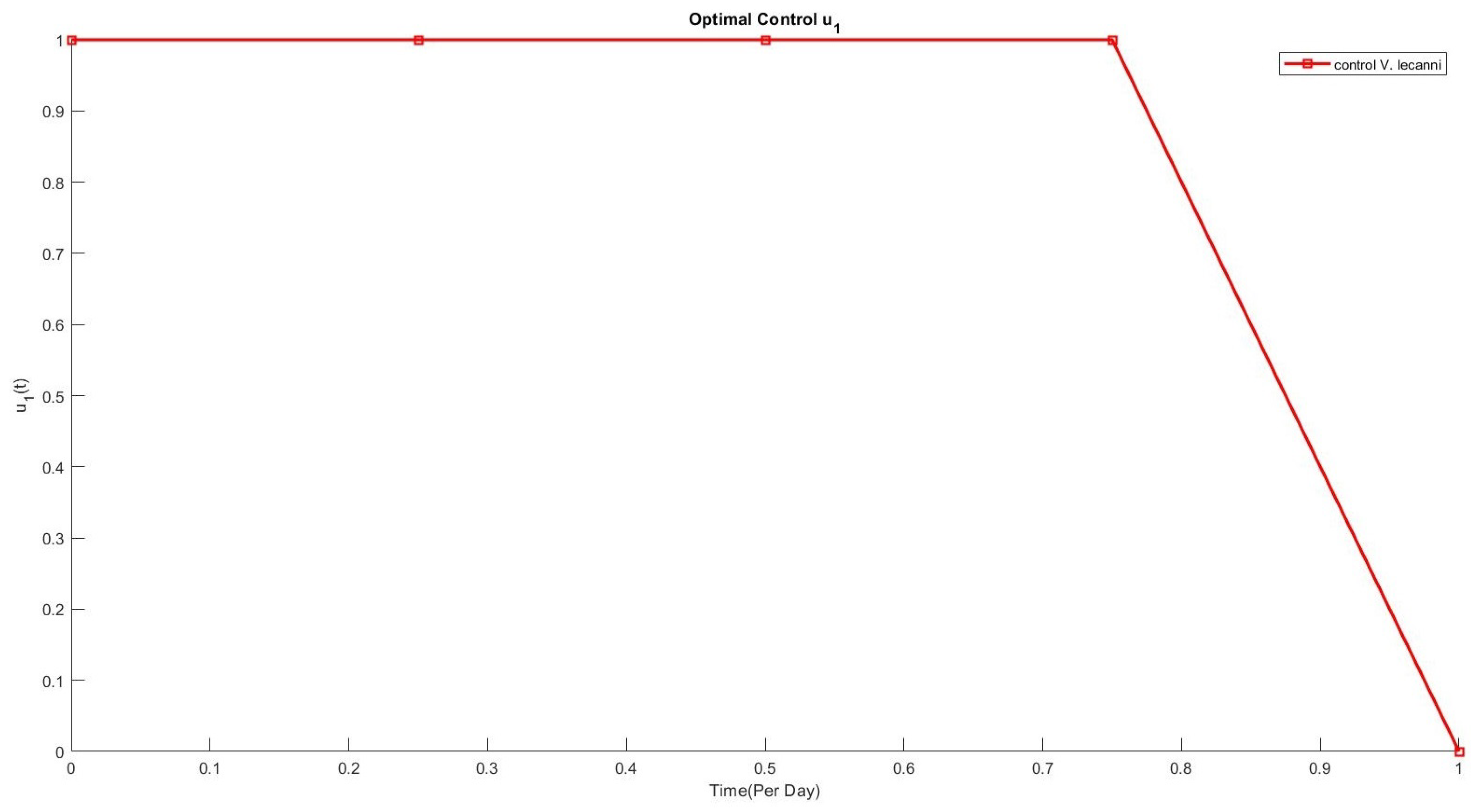
| Variable with Values | Definition |
|---|---|
| C. annuum population | |
| B. tabaci population | |
| Vegetative phase of Susceptible C. annuum | |
| Vegetative phase of Infected C. annuum | |
| Generative phase of Susceptible C. annuum | |
| Generative phase of Infected C. annuum | |
| B. tabaci Susceptible insect | |
| B. tabaci Infected insect | |
| Recruitment of C. annuum | |
| Recruitment of B. tabaci | |
| Rate of growth from vegetative to generative phase | |
| Rate of infected C. annuum in the vegetaive phase | |
| Rate of infected C. annuum in the generative phase | |
| Rate of B. tabaci infection in the vegetaive phase | |
| Rate of B. tabaci infection in the generative phase | |
| V. lecanii | |
| The death rate of C. annuum | |
| Rate of natural death in B. tabaci | |
| The death rate of B. tabaci due to curative intervention |
Publisher’s Note: MDPI stays neutral with regard to jurisdictional claims in published maps and institutional affiliations. |
© 2022 by the authors. Licensee MDPI, Basel, Switzerland. This article is an open access article distributed under the terms and conditions of the Creative Commons Attribution (CC BY) license (https://creativecommons.org/licenses/by/4.0/).
Share and Cite
Nisar, K.S.; Logeswari, K.; Vijayaraj, V.; Baskonus, H.M.; Ravichandran, C. Fractional Order Modeling the Gemini Virus in Capsicum annuum with Optimal Control. Fractal Fract. 2022, 6, 61. https://doi.org/10.3390/fractalfract6020061
Nisar KS, Logeswari K, Vijayaraj V, Baskonus HM, Ravichandran C. Fractional Order Modeling the Gemini Virus in Capsicum annuum with Optimal Control. Fractal and Fractional. 2022; 6(2):61. https://doi.org/10.3390/fractalfract6020061
Chicago/Turabian StyleNisar, Kottakkaran Sooppy, Kumararaju Logeswari, Veliappan Vijayaraj, Haci Mehmet Baskonus, and Chokkalingam Ravichandran. 2022. "Fractional Order Modeling the Gemini Virus in Capsicum annuum with Optimal Control" Fractal and Fractional 6, no. 2: 61. https://doi.org/10.3390/fractalfract6020061
APA StyleNisar, K. S., Logeswari, K., Vijayaraj, V., Baskonus, H. M., & Ravichandran, C. (2022). Fractional Order Modeling the Gemini Virus in Capsicum annuum with Optimal Control. Fractal and Fractional, 6(2), 61. https://doi.org/10.3390/fractalfract6020061








